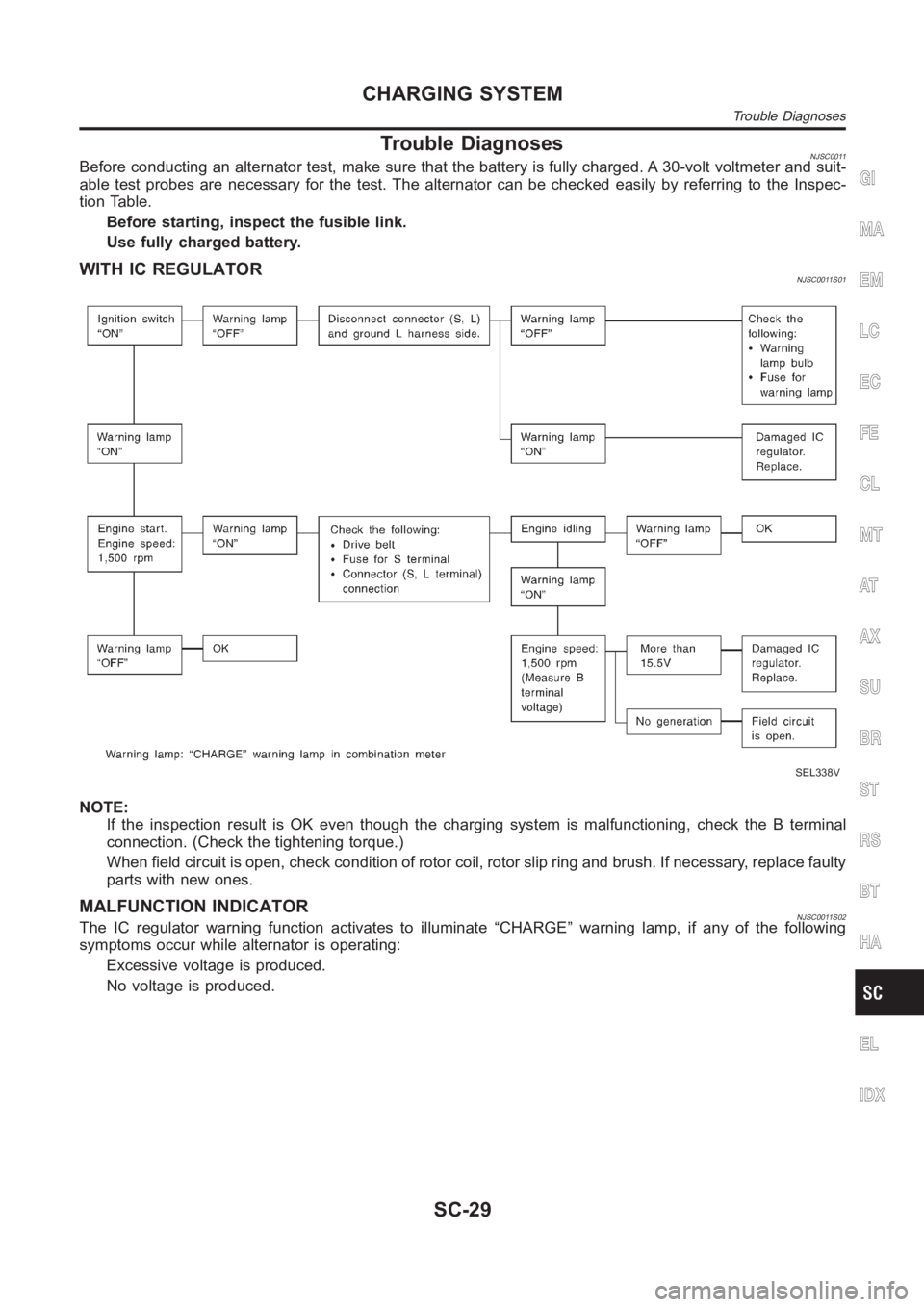Page 3116 of 3189

B: STANDARD CHARGENJSC0017S04
SEL758W
*1: SC-4 *2: SC-7
Fig. 4 INITIAL CHARGING CURRENT SETTING (Standard charge)
CON-
VERTED
SPECIFIC
GRAVITYBATTERY TYPE
28B19R(L)
34B19R(L)
46B24R(L)
55B24R(L)
50D23R(L)
55D23R(L)
025 [YUASA type code]
027 [YUASA type code]
65D26R(L)
80D26R(L)
063 [YUASA type code]
067 [YUASA type code]
096 [YUASA type code]
75D31R(L)
95D31R(L)
115D31R(L)
110D26R(L)
95E41R(L)
065 [YUASA type code]
075 [YUASA type code]
096L [YUASA type code]
010S [YUASA type code]
130E41R(L)
1.100 -
1.1304.0 (A) 5.0 (A) 6.0 (A) 7.0 (A)8.0
(A)9.0 (A) 10.0 (A)13.0
(A)
1.130 -
1.1603.0 (A) 4.0 (A) 5.0 (A) 6.0 (A)7.0
(A)8.0 (A) 9.0 (A)11 . 0
(A)
1.160 -
1.1902.0 (A) 3.0 (A) 4.0 (A) 5.0 (A)6.0
(A)7.0 (A) 8.0 (A)9.0
(A)
1.190 -
1.2202.0 (A) 2.0 (A) 3.0 (A) 4.0 (A)5.0
(A)5.0 (A) 6.0 (A)7.0
(A)
Check battery type and determine the specified current using the table shown above.
After starting charging, adjustment of charging current is not necessary.
BATTERY
Battery Test and Charging Chart (Cont’d)
SC-10
Page 3117 of 3189
Fig. 5 ADDITIONAL CHARGE (Standard charge)
SEL759W
*: SC-7
CAUTION:
Do not use standard charge method on a battery whose specific gravity is less than 1.100.
Set charging current to value specified in Fig. 4. If charger is not capableof producing specified
current value, set its charging current as close to that value as possible.
Keep battery away from open flame while it is being charged.
When connecting charger, connect leads first, then turn on charger. Do notturn on charger first,
as this may cause a spark.
If battery temperature rises above 60°C (140°F), stop charging. Always charge battery when its
temperature is below 60°C (140°F).
C: QUICK CHARGENJSC0017S05
SEL760W
*: SC-7
GI
MA
EM
LC
EC
FE
CL
MT
AT
AX
SU
BR
ST
RS
BT
HA
EL
IDX
BATTERY
Battery Test and Charging Chart (Cont’d)
SC-11
Page 3118 of 3189
![NISSAN ALMERA N16 2003 Electronic Repair Manual Fig. 6 INITIAL CHARGING CURRENT SETTING AND CHARGING TIME (Quick charge)
BATTERY
TYPE
28B19R(L)
34B19R(L)
46B24R(L)
55B24R(L)
50D23R(L)
55D23R(L)
65D26R(L)
80D26R(L)
025 [YUASA type code]
027 [YUASA t NISSAN ALMERA N16 2003 Electronic Repair Manual Fig. 6 INITIAL CHARGING CURRENT SETTING AND CHARGING TIME (Quick charge)
BATTERY
TYPE
28B19R(L)
34B19R(L)
46B24R(L)
55B24R(L)
50D23R(L)
55D23R(L)
65D26R(L)
80D26R(L)
025 [YUASA type code]
027 [YUASA t](/manual-img/5/57350/w960_57350-3117.png)
Fig. 6 INITIAL CHARGING CURRENT SETTING AND CHARGING TIME (Quick charge)
BATTERY
TYPE
28B19R(L)
34B19R(L)
46B24R(L)
55B24R(L)
50D23R(L)
55D23R(L)
65D26R(L)
80D26R(L)
025 [YUASA type code]
027 [YUASA type code]
063 [YUASA type code]
067 [YUASA type code]
096 [YUASA type code]
065 [YUASA type code]
075 [YUASA type code]
096L [YUASA type code]
010S [YUASA type code]
75D31R(L)
95D31R(L)
115D31R(L)
110D26R(L)
95E41R(L)
130E41R(L)
CURRENT
[A]10 (A) 15 (A) 20 (A) 25 (A) 30 (A)40
(A)
CONVERTED SPECIFIC GRAVITY
1.100 -
1.1302.5 hours
1.130 -
1.1602.0 hours
1.160 -
1.1901.5 hours
1.190 -
1.2201.0 hours
Above
1.2200.75 hours (45 min.)
Check battery type and determine the specified current using the table shown above.
After starting charging, adjustment of charging current is not necessary.
CAUTION:
Do not use quick charge method on a battery whose specific gravity is less than 1.100.
Set initial charging current to value specified in Fig. 6. If charger is notcapable of producing
specified current value, set its charging current as close to that value aspossible.
Keep battery away from open flame while it is being charged.
When connecting charger, connect leads first, then turn on charger. Do notturn on charger first,
as this may cause a spark.
Be careful of a rise in battery temperature because a large current flow is required during quick-
charge operation.
If battery temperature rises above 60°C (140°F), stop charging. Always charge battery when its
temperature is below 60°C (140°F).
Do not exceed the charging time specified in Fig. 6, because charging battery over the charging
time can cause deterioration of the battery.
BATTERY
Battery Test and Charging Chart (Cont’d)
SC-12
Page 3133 of 3189

System DescriptionNJSC0009The alternator provides DC voltage to operate the vehicle’s electrical system and to keep the battery charged.
The voltage output is controlled by the IC regulator.
Power is supplied at all times to alternator terminal 4 (S) through:
10A fuse (No. 39, located in the fuse and fusible link box).
Terminal B supplies power to charge the battery and operate the vehicle’s electrical system. Output voltage
is controlled by the IC regulator at terminal 4 (S) detecting the input voltage. The charging circuit is protected
by the 100A fusible link.
The alternator is grounded to the engine block.
With the ignition switch in the ON or START position, power is supplied
through 10A fuse [No. 30, located in the fuse block (J/B)]
to combination meter terminal 30
Ground is supplied to terminal 18 of the combination meter through terminal 3 (L) of the alternator. With power
and ground supplied, the charge warning lamp will illuminate. When the alternator is providing sufficient volt-
age with the engine running, the ground is opened and the charge warning lamp will go off.
If the charge warning lamp illuminates with the engine running, a fault is indicated.GI
MA
EM
LC
EC
FE
CL
MT
AT
AX
SU
BR
ST
RS
BT
HA
EL
IDX
CHARGING SYSTEM
System Description
SC-27
Page 3134 of 3189
Wiring Diagram — CHARGE —NJSC0010
YEL607D
CHARGING SYSTEM
Wiring Diagram — CHARGE —
SC-28
Page 3135 of 3189

Trouble DiagnosesNJSC0011Before conducting an alternator test, make sure that the battery is fully charged. A 30-volt voltmeter and suit-
able test probes are necessary for the test. The alternator can be checked easily by referring to the Inspec-
tion Table.
Before starting, inspect the fusible link.
Use fully charged battery.
WITH IC REGULATORNJSC0011S01
SEL338V
NOTE:
If the inspection result is OK even though the charging system is malfunctioning, check the B terminal
connection. (Check the tightening torque.)
When field circuit is open, check condition of rotor coil, rotor slip ring and brush. If necessary, replace faulty
parts with new ones.
MALFUNCTION INDICATORNJSC0011S02The IC regulator warning function activates to illuminate “CHARGE” warning lamp, if any of the following
symptoms occur while alternator is operating:
Excessive voltage is produced.
No voltage is produced.
GI
MA
EM
LC
EC
FE
CL
MT
AT
AX
SU
BR
ST
RS
BT
HA
EL
IDX
CHARGING SYSTEM
Trouble Diagnoses
SC-29
Page 3136 of 3189
ConstructionNJSC0012
MEL480HB
MEL141LC
CHARGING SYSTEM
Construction
SC-30
Page 3137 of 3189
MEL141LA
MEL142L
GI
MA
EM
LC
EC
FE
CL
MT
AT
AX
SU
BR
ST
RS
BT
HA
EL
IDX
CHARGING SYSTEM
Construction (Cont’d)
SC-31